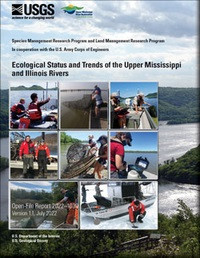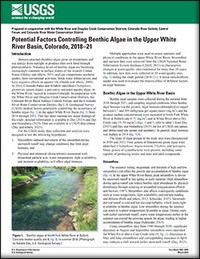
Product Details
- Product Number
- 534146
- Series
- OFR-2022-1039
- Scale
- NO SCALE
- Alternate ID
- OFR-2022-1039
- ISBN
- 978-1-4113-4473-0
- Authors
- EDITED BY JEFFREY N HOUSER
- Version Date
- 01/01/2022
- Regions
- IA, IL, IN, MN, MO, ND, SD, WI
- Countries
- USA
- Media
- Paper
- Format
- Printed but Unbound
- Digital Reproduction
- Yes
Additional Details
- Description
-
Ecological status and trends of the Upper Mississippi and Illinois Rivers
First posted June 22, 2022
Revised July 14, 2022
For additional information, contact: Director, Upper Midwest Environmental Sciences Center U.S. Geological Survey 2630 Fanta Reed Road La Crosse, WI 54603
Contact Pubs Warehouse
Executive Summary
This report assesses the status and trends of selected ecological health indicators of the Upper Mississippi River System (UMRS) based on the data collected and analyzed by the Long Term Resource Monitoring element of the Upper Mississippi River Restoration program, supplemented with data from other sources. This report has four objectives: providing a brief introduction of the UMRS, including its significance, history, modern-day stressors, and recent research; using ecological indicators to describe the status of the river system and where and how it has changed from circa 1993 to 2019; discussing management and restoration implications of these changes; and highlighting the fundamental role of long-term monitoring in the understanding, management, and restoration of large-floodplain rivers.
The data were collected in the six Long Term Resource Monitoring element study reaches that spanned much of the UMRS and the various gradients contained therein. These study reaches included Navigation Pools 4, 8, 13, and 26; the part of the Unimpounded Reach of the Upper Mississippi River between Grand Tower and Cairo, Illinois; and the La Grange Pool on the Illinois River. The indicators included in this report describe the status and trends for the hydrology, geomorphology, floodplain vegetation, water quality, vegetation, and fishes of the UMRS. Many of the indicators of river ecosystem health changed significantly over the nearly 30 years of our evaluation. However, there was substantial spatial variability in the magnitude and timing of those changes among study reaches. Few indicators changed everywhere or nowhere; most indicators changed in some reaches but not others. The quantitative assessments of these indicators describe how the conditions of the river differ across hydrogeomorphic and climate gradients and through time and are intended to support the restoration and management of the UMRS.
- Height In Inches
- 11.000
- Width In Inches
- 0.500
- Length In Inches
- 8.500
- Two Sided
- Yes
- Pieces
- 1





